Documentation + User Guide
Hello and welcome to the final devlog for Dungeonator. The main purpose of this devlog is to provide the readers with the user guide and documentation relating to my game for KIT109's Assignment 4 Game Project. Regarding the documentation to be outlined and discussed throughout the devlog, each section will be addressed as follows:
- Description of how well the final game compares to the vision laid out in the concept document.
- Summary of the feedback received for the elements tested and observations made during the Week 12 Testing Session and how the feedback influenced the final game
- An asset list with descriptions of their purpose/use and relevant references of materials from other sources.
- User guide containing the final name of the game with a basic description of gameplay and controls.
User Guide
Dungeonator
You are an adventurer that has stumbled into what seems to be a dungeon, with no way back out you must traverse through the dungeon floors finding items and weapons along the way to help you combat lurking enemies and pass through doors, to defeat the 'Dungeon Master' and escape. You must become 'The Dungeonator'.
Basic Controls
W = Move player up
A = Move player left
S = Move player down
D = Move player right
(Use WA, WD, SD, SA to move in diagonal directions)
E = Pick up items, open doors, initiate dialogue
Q = Drop items
R = Close dialogue, open chests
Space = Attack
1, 2, 3 = Switch between items in inventory
Dungeonator Gameplay Functions
Title Screen
This screen allows the player to begin the game by pressing the start game button, and also allows the player to view the 'how to play' screen to understand the controls used throughout the game. A quit game button is also included but would mainly be used in a PC build rather than a WebGL.
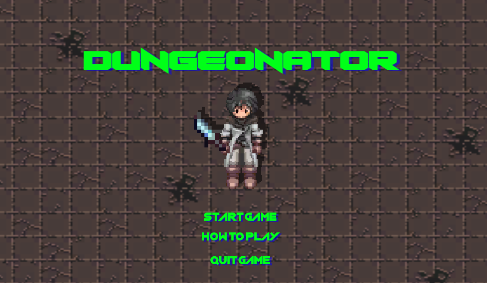
How To Play Screen
This screen shows the player all of the current controls associated with the game.
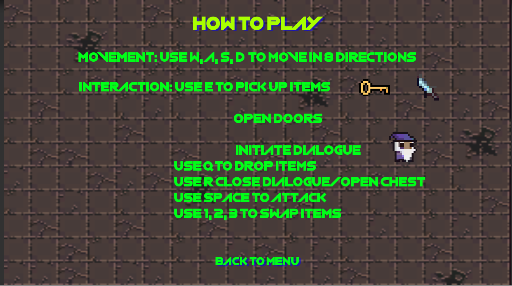
Initial Dialogue
The dialogue below gives the brief background of the game and also introduces the player to the wizard.

The Dungeonator (Player)
Move around the rooms, interacting with objects/NPC traversing the dungeon and defeating enemies along the way.
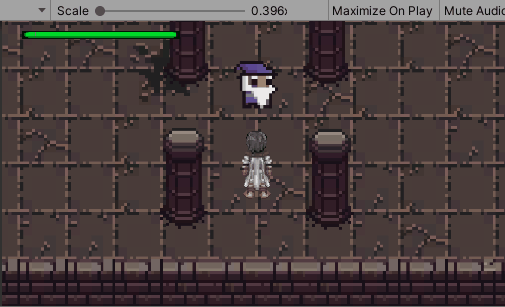
Sword Attack
The only weapon currently in game is his trusty sword. Using the sword to vanquish enemies but sometimes could kill wrong one.
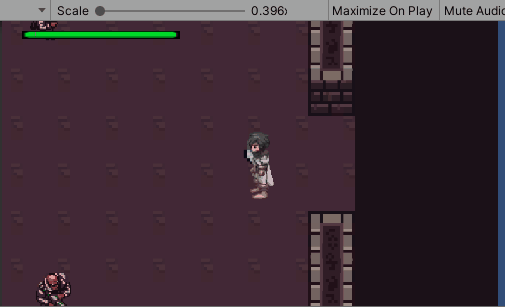
Aim of Game
The way to win the game is to defeat the enemies and take out the dungeon master (End game scene Incomplete).
Items
The items that can be used in the current game include a sword, key and health potions.
They can help the player to attack enemies, unlock certain doors and heal themselves (Issues with healing player health)


Chests/Dialogue
The chests seen throughout different levels are the sole means for the player to obtain items in game.
The dialogue associated with the game is brought to the player via the wizard that initially helps the player at the beginning and end rooms of the game.

Enemies
The enemies are shown as a normal grunt throughout the rooms and the Dungeon Master is depicted as a large hooded figure in the final room. At this stage there is only one basic enemy type but would like to incorporate more enemy types and bosses in the future. When the player collides with the enemy it gets randomly pushed slightly away and should have possibly changed the mass of the enemies to limit it to a certain degree.


Doors/Room Entries
Currently there are two types of doors implemented into the game that the player can use to travel between certain rooms. The actual door is currently only used to indicate the final room where the Dungeon Master resides that is only accessible via a key, and the second door is designated as a secret door that slides open for the player to enter through. There are multiple doorway kind of entries in the game which when triggered by entering them, sends the player to a different dungeon room to traverse.
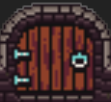

Rooms
The rooms associated with the game were developed to give the typical dungeon like feel and are one of the more stand out aspects of the game, which can either make it more visually appealing/exciting or not depending if the rooms are complete. The current rooms in the game are not a large number and background/decoration tilemaps are incomplete on a couple rooms seen below but the basics of them can be mostly seen. The second and fourth images show the basic room with either enemies/player or not but are currently incomplete for the decorations side to improve the rooms and incorporate other elements.

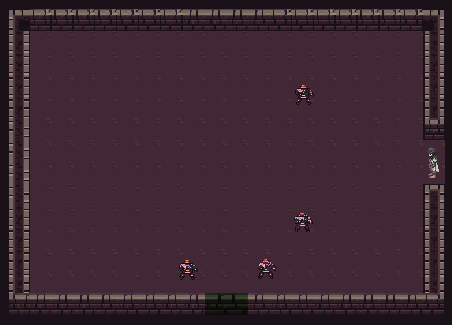

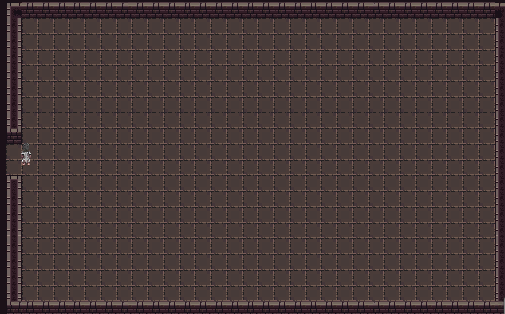

Comparison between the Initial Game Concept and Final game
Dungeonator is a 2D isometric platform game and would be classed as action/adventure like it was mentioned in the concept document.
Looking back at the initial game concept not all of the key features that I had wanted were fully implemented into the current final game which probably should have been not so difficult to achieve and unfortunately didn't spend enough time on and focused moreso on basic/difficult interactions within the game.
I was able to produce multiple rooms for the player to interact with but not all of the rooms had many intractable elements implemented into them due to procrastination and finding different features that I had implemented to be quite more difficult than I had originally thought.
Originally I had thought of making it so the player could choose between a male or female character but was unable and unsure how to do so.
The enemies associated with the game were quite undermining in comparison to what I wanted and said in my concept, as I wanted to not only have that typical big boss enemy but also have multiple basic enemies throughout the rooms for the player to defeat. What I could of done to achieve it instead of just the basic enemy, should have been to use different behaviours on different enemy duplicates to somewhat achieve this.
Features from my concept that I was able to implement into the game was giving the player the ability to move in eight directions to give more of an effect for an isometric game, simple keyboard controls for movement and limiting the number of keys to be used for the interactions, using a sword to combat enemies (although it still doesn't fully work the way it should), some story line dialogue implemented, and assets chosen to be aesthetic and visually appealing to players that also fit the dungeon theme.
Summary of Game Feedback
Visual appeal of game
The visual appeal of the game people commented on from the testing session was nice to hear that they had thought it was great and didn't require much fixing up. One of the suggestions was to add a shadow behind the player to give more of an effect which was a nice touch to the title screen.
The look and feel of the title screen was well received and didn't require much time to do a bit more polishing to make it better.
Bug finding
The main bug found was not being able to pick up the key/more than one object and having doors on doors and rooms under development. Other bugs found were around walking through objects that the player shouldn't have done, and the sword not appearing where it should be. Most of these bugs were able to be fixed except properly fixing the sword displaying correctly throughout the 8 directions the player can move in.
Level designs
The level designs were received well from the feedback given by those testing and how it suited the genre nicely.
Enemy interaction and Player movement
Those testing said the player movement was intuitive and consistent and that they fitted well together, which was nice to read, the only issue with the enemy interaction was that the player could be damaged but couldn't attack them back due to me forgetting to do a player attack script. This was mostly fixed where the player can now attack but it is quite dodgy in some aspects.
Item interaction
The main comment received which is now all fixed was that the player couldn't hold more than one item and that there were too many interaction controls which have been since simplified.
Suggestions
The suggestions made to help improve the game were quite helpful and wished I actually spent more time to implement all of the suggestions to make Dungeonator even better. The controls were fixed so that less keys were needed for interacting with objects, a how to play scene was created to illustrate the controls and actions associated with them, health and more dialogue were implemented, and sort of more levels were created but not as many as I would have liked and finished.
Overall comments
Reading the overall comments about my game, it seemed like those that had tested it enjoyed the different aspects associated with it and were keen to see more things implemented and to fit in more easy features to make it feel more complete.
Asset List
My assets
Art -
Healthbar & Bar - Displays the health of player as a UI element
Title Screen Art
Animations -
Idle & Walking - Used for the players movement
Animator -
Player controller - Used to controls the player movement states
Scenes -
Dungeon Room 0 - This is the beginning room scene where it all happens
Dungeon Room 1 - This scene would usually have at least a couple of doorways to other areas and will be filled with the correct tiles in the future for fun
Dungeon Room 2 - Incomplete, Will be a puzzle related room in the future with different elements and tiles to make it fun
Dungeon Room 3 - This scene is the final room that the Dungeon Master resides and his minions
How to Play - Scene that shows the players controls for movement and interaction and has a back to menu button
Secret Room - This is a small basic looking dungeon scene that has three chests inside for the player to interact with
Title - This scene is the title screen with start game, how to play and quit game buttons
Prefabs -
Blood - Created from the particle system to use on the player and enemies for when they die
Door Lock - Used to show the door is locked and so the unlock door script can interact with the key when the player collects it
CM vcam1 - Used so it follows the player throughout the entire game due to the player being set to don't destroy on load
Key - Unused as this prefab was mainly for testing purposes
Pillar - Used in the beginning room so elements of the sprite could be changed rather than leaving it on the tilemap
Scene Switch Sprite - Used so when the player triggers it by moving onto it, it transports the player to another room
Wizard - Used for putting him in multiple rooms for dialogue purpossess
Player - Used for multiple rooms and so each rooms initial player sprite will have the correct scripts
Scripts -
HealthPotion - Not used yet due to issues but will heal the player back to full health
ItemDestroy - Unused, possibly will be used for the key and health potions so that when the player uses them they disappear from the inventory
PlayerAttack - Allows the player to attack and kill enemies
QuitGame - Allows the user to quit the game from the title scene but would only be used for a PC build
RespawnLocation - Sets the respawn locations when entering into another room so that the player is in the correct location from the doorway they entered from
SecretDoorOpen - Used to open the secret door and sliding it open for the player to move past into the room
UnlockDoor - Used to unlock the Dungeon Masters lair door if the player has the correct key
WizardDialogue - Used to display and close the dialogue associated with the wizard NPC
Other assets
Fonts -
Dark Seed Font - Used for dialogue (fontspace.com)
Revenant Font - Used for the title and how to play screen text (fontspace.com)
Sprite/Tilemap Sheets -
Dungeon Walls - Used for the room backgrounds (https://aekae13.itch.io/16x16-dungeon-walls-reconfig)
Dungeon Tileset - Used for room backgrounds (https://0x72.itch.io/16x16-dungeon-tileset)
Player Sprites (https://www.moddb.com/news/revamping-the-game)
ShortSword - (KIT109 Sprite) For player weapon
Key - Unlocking doors (from dungeon wall sheet)
HealthPotion - Healing player (from dungeon tileset)
Prefabs - (KIT109)
BaseEnemy - Making multiple enemy copies (KIT109 Tutes)
Chest - Multiple copies for the chest
Animator - (KIT109)
EnemyController - Controls the states used by the enemies and their movement
Animations - (KIT109)
Walking and Standing - Used for the enemy movement animations (KIT109 Tutes)
Chest - Used for opening the chest and displaying the object inside
Scripts from KIT109 Tutorials - (Some may be modified)
CharacterZoomZone - Unused
DestroySelfAndKillOtherOnCollision - Unused, might use for killing enemy
EightWayAnimation - Used for enemy movement
EightWayMovement - Used for player movement in 8 directions
Flee - Unused, might in future
HurtOnCollision - Used to decrease player health when it collides with enemy
Killable - Unused, could be used with destroy self and kill other
Mover - Unused
Order - Used to make objects show in front or behind another object in the room to make it more realistic
PlayerHealth - Used for setting and displaying the players health and using the blood effect when player dies
Pursuit - Used for the enemies to pursue the player
SceneSwitcher - Used to switch scenes from one room to another
Seek - Unused, might in future
SetAnimatorBooleanOnTriggerStay - Used to set when the player is near to the enemy
Shoot - Unused
SpawnEnemy - (Not working currently) Will be used to spawn x amount of enemies in any room
TriggerDetection - Used to detect when the player enters the doorway to switch to certain room
TreasureOpen - Used to initiate the animation associated with the chests
Wandering - Unused
Sourced Scripts -
PickupWeapon - Used to pick up a certain amount of items to put inventory, drop items and select items. (Has been modified quite a bit from the original code) (https://answers.unity.com/questions/1544320/c-weapon-pickup-script.html)
Files
Get Dungeonator
Dungeonator
More posts
- Game TestingOct 06, 2020
- Polish and UIOct 04, 2020
- Presentation & GraphicsSep 27, 2020
- Enemies/Interaction/PuzzlesSep 22, 2020
- Basic Level BlockingSep 13, 2020
- Player MovementAug 30, 2020
- Game ConceptAug 28, 2020
Leave a comment
Log in with itch.io to leave a comment.